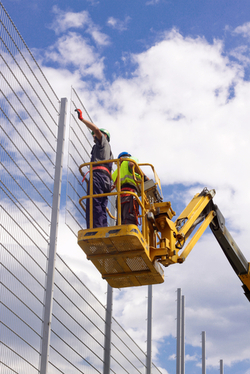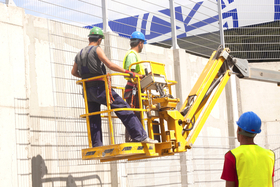Prepare to Work Safely From Work Platforms

Site assessments, machine inspections, and safety gear are simple keys to avoiding accidents with aerial-work platforms
Aerial-work platforms (AWPs) are fairly simple, stable machines but because they raise people to heights, there is inherent risk in their operation. Essentially, all operators' manuals explain how an operator should answer each of these questions for each make and model of machine. The intent of this story is not to repeat all of that detail, but to focus on some of the key safety issues common to AWPs, including:
- Work site environment
- Wind and weather Conditions
- Safety gear
- Equipment maintenance and employee training
Work site environment
Work site assessments are particularly important on changing construction sites because of the risk of contact with power lines or crushing obstacles, and because of the risk of tipping on unimproved surfaces.
Walk around the site to check ground conditions. You're looking for:
- Uncompacted fill
- Holes or ditches
- Cellars and basements
- Building projections or other overhead obstacles
- Power lines or electrical equipment
Check in all directions within the machine's working envelope. Make sure any floor or other structure you'll be driving over is strong enough to support the machine's weight (individual tire loads should be marked on the machine, just above each tire). Look carefully at all of the air space where the platform is likely to work. Plus, remember that few AWPs are insulated from electrical strikes. So unless a machine is clearly identified as such, operate it as if you and the machine will be the easy path for current to flow to ground if you come too close to voltage.
You don't have to touch wires carrying more than 300 volts to become the path to ground. As voltage increases, the gap that electrical current can arc across grows. The minimum safe approach distance (MSAP) is 45 feet for the highest voltages that you are likely to encounter. If voltage is unknown, the AWPT recommends a simple rule of thumb: Maintain an MSAP for any part of the machine of 50 feet from wires mounted on steel towers and 30 feet from wires on poles. Don't forget to allow room for wires to sway in the wind.
The AWPT recommends using ground-level barriers to mark boundaries where a work platform is safe from entering a dangerous space. Another option is high-level markers that make the wires or the MSAP more visible to lift operators.
Wind and weather conditions
Weather conditions play a role in AWP stability. Underfoot conditions that were safe when the site was dry in the morning could become dangerously unstable in the afternoon, after a rain.
Don't use a lift in winds greater than 28 miles per hour. Unless someone has an anemometer handy, this is an operator's judgment call. Aerial Work Platform Training Inc., the training subsidiary of an independent AWP-safety organization backed by most equipment manufacturers, recommends using the Beaufort Scale for estimating wind force.
This scale describes winds in the 28-mph range as a strong breeze capable of putting large tree branches in motion. The wind may whistle over power lines, and umbrella users have to be careful to stay in control of their shelter. In contrast, winds up to 24 mph will cause small trees in leaf sway and will whip up small whitecaps on ponds and lakes.
Do not increase the surface area that wind can work on by carrying or attaching sheets of plywood or other materials to the platform. You don't want create a sail that will catch the wind and decrease machine stability. Manufacturers that build lifts or accessories specifically to carry these types of materials will account for the load's affect on stability, but if carrying capacity is added by anyone other than the manufacturer, it's hard to be sure of its affect on stability.
Hardhats and body harnesses

Wear a hardhat, or other approved headgear when operating an aerial lift. After all, your head becomes the highest point when operating.
Full-body harness with adjustable lanyard as short as possible is required for boom-lift occupants. People in a boom's platform can be bounced around and even launched over the guardrails if the platform rolls over a sudden change in grade or if obstacles interfere with the boom in motion.
Lanyards should only be attached to the anchor provided by the manufacturer specifically for that purpose, not the guard rails and never to any other object or a structure outside the platform.
Stepping from a lift platform to an adjacent structure is not recommended because of the fall risk inherent in the maneuver but, if it's necessary, you'll need a safety harness and two lanyards. ANSI Fall Protection Standards require 100-percent tie off - you must be tied off at all times in situations like this. That means you need two lanyards — one tied off to an anchor in the platform and the other tied off to a suitable anchor on the structure to which you're transferring. The platform floor should be within one foot of the structure to which you are transferring.
Scissor lifts don't experience the same dynamics as a boom. What scissors give up in reach, they gain in stability, and occupants are unlikely to be tossed off the deck unless they climb or lean over the railings and fall or the machine is toppled. Therefore, while some scissor-lift manufacturers recommend fall-protection, safety harness and lanyard are not required for scissors operators.
Inspection checklist
Before going up to work, the operator is responsible for thoroughly inspecting the machine (even if another operator has already put the unit into service that day) to be sure it's in good working order and ready to perform. Review the section in the machine's operator's manual on pre-operation inspections for a checklist of things to look for. Here are some of the most common items:
- Tires. Always confirm recommended tire-inflation pressures, as it will significantly affect the lift's stability.
- Controls. Both the ground controls and controls in the platform should be checked for proper function. Never slam a control lever from one position, through neutral, to the opposite position. Always come to neutral, stop, and then proceed in the desired direction. All of the control levers and switches should return automatically to the neutral position when released, and the platform controls should only operate when the foot switch has been depressed.
- Boom. When extending or retracting the boom, check for delayed movement on the fly section, indicating loose cables.
- Safety cutouts. Push the emergency stop switches while operating the controls to make sure that all functions stop. Operate functions against the machine's cutout switches. Try to raise the platform without outriggers or axles extended and cycle a boom lift to the furthest extent of its operating envelope to test the boom control system, for instance. If these safety limiters don't stop the machine automatically before it moves into an unstable position, shut the machine down and have the systems repaired before going to work.
- Platform. Raise the platform a few feet, find the manual descent system or auxiliary power system, shut the machine down and use the emergency system (according to the operator's manual) to lower the platform.
Employee training
It's the operator's responsibility to make sure that a worker on the ground is properly trained and has demonstrated the ability to operate the lift from the ground controls. Trained people on the ground will be the operator's best chance of being rescued if something goes wrong while he is aloft. People trained to use ground controls should also know how to use the auxiliary systems for lowering a disabled lift.
Be aware of limited site distance when driving boom lifts from the proper position, with the boom centered between the rear wheels. Before traveling, check to be sure that:
- The stabilizers or outriggers are properly stowed
- There are no ramps, trenches, holes or other dangerous conditions along the intended path
- There are no overhead cables, building projections or other overhead hazards
- People on the ground have been warned
- Nothing has been left unsecured or liable to fall from the work platform
- No hoses, cables, or wires are hanging or trailing from the machine
Note: Only AWPs that are designed to do so should travel with workers raised in the platform, and only units designed for climbing slopes should be driven on them. When driving a work platform, the AWPT strongly recommends getting a person on the ground to guide you. A small jolt caused by tires running over an uneven surface will be magnified considerably at the platform, even threatening to catapult the occupants or tip the machine.
Additional safety tips
- Before raising a platform, make sure the machine is leveled within manufacturer's limits and located on a firm surface. Don't use a machine's tilt alarm as a level indicator because it will only sound when the machine is on a severe slope.
- Extendable axles must be extended, or stabilizers deployed to ensure the stability of lifts.
- Know the weight of all the occupants, tools and materials going up in the platform, and make sure the total load is within the machine's maximum safe operating load.
- Do not use drive functions to position the platform close to obstacles. Use boom functions instead.
- Never use guard rails, ladders, staging or anything else in the platform to extend your reach or height for any purpose. Keep your feet firmly on the deck of the platform at all times.
Don't use platform controls to free a platform that is caught or snagged by a nearby structure or obstacle. Get people out of the platform before attempting to free the platform using the ground controls.
Ready to Compare Aerial Lifts Price Quotes?